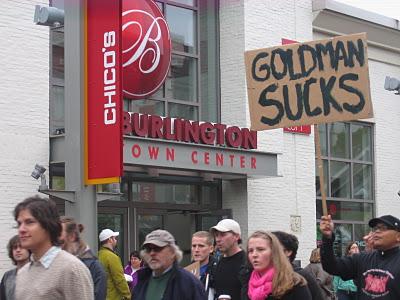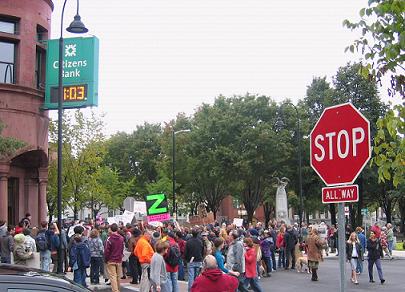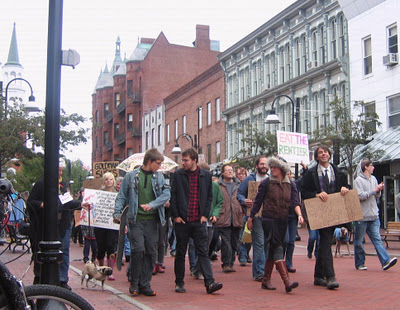
Meanwhile, from New York City to San Francisco, thousands of people are protesting the growing wealth disparity between large corporations and the super rich and almost everyone else. The movement has spread to at least 147 cities in the US and 28 overseas, according to Bloomberg News Service. Events are being planned in more than 45 states and cities including Boston, Chicago, Denver and Seattle. In the nation’s capital Occupy DC has an encampment in McPherson Square, a few blocks north of the White House.
Here is some audio of the voices and ideas as people gathered on October 2 at the front door of a Burlington, Vermont bank: Voices of Occupy Vermont.
After a brief warm up in City Hall Park, the crowd marched on Church Street’s four block pedestrian mall as shoppers watched, then proceeded – without a permit – down local streets to the Citizens Bank, located across from City Hall. A wide variety of topics, including the struggle with Entergy over the expected shutdown of the Vermont Yankee Nuclear Plant next March, were addressed as various participants, standing in front of the bank’s door, took turns speaking to the crowd, which repeated key phrases so that all could hear.
“You go bankrupt you lose your house,” said organizer Matthew Cropp. “The largest banks in this country go bankrupt and they get a free ride from the government. They get billions of dollars in bailout money.” Now imagine each sentence chanted by 125 people.

On June 13, as part of a “day of action” in New York, a group first attempted to occupy Liberty Park, a strategic public space closest to Wall Street and the New York Federal Reserve building. Although that effort failed, a People’s General Assembly was formed to facilitate an organized non-violent movement. Today Liberty Park is the site of what looks like a permanent encampment, attracting thousands and serving as the nexus for democratic decision-making and proposals for action.
On September 17, Adbusters magazine issued an open call for an occupation of Wall Street. Various activists already at work, including movement names like Anonymous, A99, OpESR, US Day of Rage and the NYCGA were among the first to endorse the move. According to David DeGraw, editor of the organizing site AmpedStatus.com, the unifying principle is, “Anything you can do to rebel against the system of economic tyranny in a non-violent manner is welcome.” It’s a radical declaration, and raises questions about the impulses fueling this uprising. In some ways it mirrors, from a left-wing position, the outrage and defiance of the conservative, anti-government Tea Party movement that has preceded it.
After close to two weeks of rallies, police arrested 700 protesters last Saturday on the Brooklyn Bridge. But this has hardly discouraged the movement. In fact, it has riled more people up.

And as it spreads, with the help of social networks that make it possible to mobilize large groups within hours, it is also sparking activism in cities and towns across the country. “We need to start looking here in Burlington with our homeless shelters being more than three times of capacity,” Burlington organizer Jonathan Leavitt told the crowd last Sunday. “And the wealthiest 1 percent see their savings growing astronomically.”
Like others springing up around the country, Burlington’s movement doesn’t just want to Occupy Wall Street, it hopes to “Occupy Vermont” and communities across the country, bringing home an activist urgency and a radical platform for change.
On October 6, activists began to gather in Freedom Plaza in Washington, D.C., for a People’s Assembly organized by a group calling itself October 2011. They have promised to stay until they develop, through a democratic process, sustainable solutions to promote universal healthcare and economic justice, as well as end the nearly decade-long Afghanistan War.
In Colorado, sit-ins are expected in at least four cities during the coming weeks, according to an Occupy Denver organizer. The group, which has been camping out in front the state Capitol for almost two weeks, hopes to attract 1,000 people for a Oct. 8 march. Meanwhile, Anonymous, a group of self-styled hacker-activists behind attacks on corporate and government websites, has vowed to support the nationwide protests by erasing the New York Stock Exchange “from the Internet” on Oct. 10.
Greg Guma is an author, editor, and former executive director of Pacifica Radio. Greg worked with Bernie Sanders in Burlington during the 1980s and wrote The People’s Republic: Vermont and the Sanders Revolution. His latest book is Big Lies: How Our Corporate Overlords, Politicians and Media Establishment Warp Reality and Undermine Democracy.
